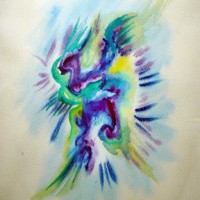Ace coverstory August 2, 2001
BY SARAH VAN ARSDALE
Who is Sybil?
Twenty years ago the answer would have come easily to any American with access to a drugstore magazine rack and a television set: Sybil is that woman who had – how many was it again? – sixteen different personalities.
You know, Sally Field? For TV enthusiasts in the seventies, Sybil was Sally Field, who won an Emmy Award for her performance in the title role of the film based on journalist Flora Rheta Schreiber’s ubiquitous 1973 bestseller, Sybil.
For those in the field of mental health, Sybil’s is the most well-known case of the extremely rare Dissociative Identity Disorder (formerly known as Multiple Personality Disorder)- the study of which made and continues to make medical history.
Sybil was, at least for a time a Sensation who’d achieved recognition of the first-name-only variety.

She also lived in Lexington Kentucky(quietly and anonymously), and produced some of her finest art here, which will be on display beginning August 3, 2001.
A few years ago, when Sybil died, Lexington residents discovered that she had been, for a quarter century, their neighbor. Sybil Isabel Dorsett is a pseudonym created by author Flora Schreiber to protect the identity of Shirley Ardell Mason, Human Being and Successful Artist.
From about the time the nation was busy being swept by Sybil Dorsett’s bizarre story to the time of her death in February, 1998 at age 75, Shirley Ardell Mason lived in Lexington, enjoying what were probably the only quiet and peaceful years of her life.
Finally a mentally sound woman in control of herself and her future, Mason spent more than 20 years as a resident of Henry Clay Boulevard, where she ran a successful art business out of her home.
Mason also enjoyed frequent visits from her friend and psychiatrist, Cornelia B. Wilbur, who was at that time a professor of psychiatry at the University of Kentucky Medical School.
Wilbur’s psychiatric treatment of Shirley Mason lasted eleven years, beginning in 1954 when the patient was a graduate student at New York City’s Columbia University.
A survivor of unthinkable physical and emotional abuse by an exceptionally talented but mentally disturbed mother, Sybil played host to sixteen different personalities, two of whom were male.

As is typical in cases of Dissociative Identity Disorder, Sybil experienced amnesic responses to acts performed by Marcia, Mary, Peggy, Mike, or others of her alter personalities, each of whom, varying in age, represented different manifestations of her response to severe childhood mistreatment.
Dr. Wilbur, whose groundbreaking and ultimately successful treatment of Sybil’s disorder earned her much acclaim, died in 1992 without having betrayed the secret of her friend and patient Shirley Mason.
It was not until shortly after Mason’s death, when New York psychiatric historian Peter Swales identified the Lexington artist as Sybil Isabel Dorsett, that even those closest to Shirley Mason learned her true identity.
What naturally followed was a rash of newspaper articles and colorful rumors in and around Lexington. According to Swales, Mason moved to Lexington from Point Pleasant, West Virginia, in an effort to maintain her privacy.
Speculation suggests, however, that Mason relocated so as to be closer to Dr. Wilbur. By the time she moved to Lexington, Mason had severed all ties from her family in Dodge Center, Minnesota, where she was born in January 1923. She never married.
In January 1999 Swales reported to the Lexington Herald-Leader, “I can tell you definitively that Shirley was very content and happy in the last quarter century of her life She had her little house, her garden, her flowers, her paintings, and her pets and her prayers, her devotions.”
The Good Neighbor
Longtime residents of Henry Clay Boulevard (while they recall having noticed the frequent comings and goings of Dr. Cornelia Wilbur and any number of pet poodles at their neighbor Shirley Mason’s house) say they never realized at the time that they were rubbing elbows with the famed Sybil.
A search for details concerning Shirley Mason’s personal life in Lexington reveals only one definitive – and most refreshing – fact: It seems that Lexington ended up being everything to Shirley Mason that she hoped it would be – a nice place where kind neighbors would allow her to go quietly about the business of being normal and bringing a little bit of something beautiful into the world on the side.
While tall tales of alleged Sybil-sightings, and even Sybil-impersonator sightings, are a dime a dozen in this town (usually spooky and hilarious at the same time, involving poodles and comparisons to Baby Jane), accounts of the real Shirley Mason from people who knew her point to a quiet, thoughtful woman, a good neighbor, who minded her own business and was rarely seen about town.
Untitled #9: This work ( in crayon) is thought to be done by the personality “Ruthie,” a 2-3 year old who was noted as being good at coloring.
Art and Madness
Although the strange nature of Sybil’s story lends it a certain undeniable mystique (as does the urban legendry that has naturally arisen in Lexington as a result of its subject having really and truly bought her groceries here), anyone wishing to really get inside Sybil’s head would do well to consult her artwork.
[They will have a chance to do so this weekend. As Flora Rheta Schreiber writes in her epilogue to Sybil: “In seven years the doctor (Cornelia Wilbur) had in fact diagnosed and treated six cases of Multiple Personality Disorder none, however, was as bright and talented a person or as complicated a case as Sybil Dorsett.” While Sybil’s alter personalities differed from one another in many respects, they shared something remarkable: the gifts of music and art. In January, 1999, a year following her death, 30 of Shirley Ardell Mason’s paintings went on sale in New York City, touted as the work of Sybil. Every painting was sold. On August 3, at least 24 paintings by Shirley Mason will go on display at Chrisman Mill Winery’s Art Gallery to celebrate the grand opening of their new venue in Lexington’s Victorian Square. “The Art of Sybil” boasts works not yet viewed in a public exhibition, including Sybil’s “Blue is the Color of Love,” as seen in Flora Schreiber’s book.]
The paintings, all of which were attained at an auction by a local private art dealer, will be available for sale. Deborah Fernand, Art Director at Chrisman Mill, has described this rare exhibit as seeming to comprise the works of not one but several different artists, each with a unique brand of style. Some pieces are signed by Mason, but others, signed by Sybil’s alter personalities, offer a startling glimpse of the artist’s not-then-realized struggle to become a single, integrated self. A painting signed ‘Mary’ is vastly different in style and content from one signed ‘Sybil,’ which in turn differs from those paintings which bear no signature at all. The words of Dr. Cornelia Wilbur appear on the backs of some pieces as explanation of a particular scene or, in some cases, a particular point in her patient’s psychiatric treatment. Sybil’s paintings provide visual landmarks along what must have been at times a terrifying path toward wholeness and wellness. That Shirley Mason’s time in Lexington was marked by a peacefulness that allowed her to reclaim her life and die with dignity suggests that wholeness was hers in the end. Everything else, whatever else there may be in someone’s storage of secrets out there, is none of our business.
“The Art of Sybil” will go on display Friday, August 3, 2001 at Chrisman Mill Winery and Art Gallery’s new location at Victorian Square, Lexington. On Saturday, August 4, at 3pm there will be a presentation at Chrisman Mill of the 1977 film Sybil. The Emmy Award-winning film stars Sally Field in the title role opposite Joanne Woodward as Dr. Cornelia Wilbur. Free popcorn provided!
Cast of Characters & Dates of “Birth”
Sybil Isabel Dorsett (1923): a depleted person; the waking self.
Victoria Antoinette Scharleau (1926): nicknamed Vicky; a self-assured, sophisticated, attractive blonde; the memory trace of Sybil’s selves.
Peggy Lou Baldwin (1926): an assertive, enthusiastic, and often angry pixie with a pug nose, a Dutch haircut, and a mischievous smile.
Peggy Ann Baldwin (1926): a counterpart of Peggy Lou with similar physical characteristics; she is more often fearful than angry.
Mary Lucinda Saunders Dorsett (1933): a thoughtful, contemplative, maternal, homeloving person; she is plump and has long dark-brown hair parted on the side.
Marcia Lynn Dorsett (1927): last name sometimes Baldwin; a writer and painter; extremely emotional; she has a shield-shaped face, gray eyes, and brown hair parted on the side.
Vanessa Gail Dorsett (1935): intensely dramatic and extremely attractive; a tall redhead with a willowy figure, light brown eyes, and an expressive oval face.
Mike Dorsett (1928): one of Sybil’s two male selves; a builder and a carpenter, he has olive skin, dark hair, and brown eyes.
Sid Dorsett (1928): one of Sybil’s two male selves; a carpenter and a general handyman; he has fair skin, dark hair, and blue eyes.
Nancy Lou Ann Baldwin (date undetermined): interested in politics as fulfillment of biblical prophecy and intensely afraid of Roman Catholics; fey; her physical characteristics resemble those of the Peggys.
Sybil Ann Dorsett (1928): listless to the point of neurasthenia; pale and timid with ash-blonde hair, an oval face, and a straight nose.
Ruthie Dorsett (date undetermined): a baby; one of the lesser developed selves.
Clara Dorsett (date undetermined): intensely religious; highly critical of the waking Sybil.
Helen Dorsett (1929): intensely afraid but determined to achieve fulfillment; she has light brown hair, hazel eyes, a straight nose, and thin lips.
Marjorie Dorsett (1928): serene, vivacious, and quick to laugh; a tease; a small, willowy brunette with fair skin and a pug nose.
The Blonde (1946): nameless; a perpetual teenager; has blonde curly hair and a lilting voice.
The New Sybil (1965): the seventeenth self; an amalgam of the other sixteen selves.
Excerpted from Sybil by Flora Rheta Schreiber.
He Said, She Said, We Said
“Dissociative Identity Disorder (formerly Multiple Personality Disorder) reflects a failure to integrate various aspects of identity, memory, and consciousness. Each personality state may be experienced as if it has a distinct personal history, self-image, and identity, including a separate name. Usually there is a primary identity that carries the individual’s given name and is passive, dependent, guilty, and depressed Individuals with this disorder experience frequent gaps in memory for personal history, both remote and recent Individuals with Dissociative Identity disorder frequently report having experienced severe physical and sexual abuse, especially during childhood. Controversy surrounds the accuracy of such reports, because childhood memories may be subject to distortion and individuals with this disorder tend to be highly hypnotizable and especially vulnerable to suggestive influences.”
– from the Diagnostic and Statistical Manual of Mental Disorders, Fourth Edition, Published in 1994 by the American Psychiatric Association, Washington D.C.








